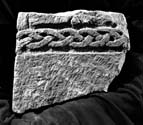Select a site alphabetically from the choices shown in the box below. Alternatively, browse sculptural examples using the Forward/Back buttons.
Chapters for this volume, along with copies of original in-text images, are available here.
Object type: Lower part of cross-shaft(?) [1]
Measurements: H. 28 cm (11 in); W. 25.8 cm (10.2 in); D. 15 cm (6 in)
Stone type: As Collingham (St Oswald) 1
Plate numbers in printed volume: Ills. 157-60
Corpus volume reference: Vol 8 p. 123
(There may be more views or larger images available for this item. Click on the thumbnail image to view.)
A thin rectangular slab, too short to determine if there was a taper. It could be the lower part of a cross- shaft, however, suggested by the plain area below the decorated face on all three surviving carved faces.
A (broad): This face is incomplete on the left. It shows, from the top, one curve from probably a large-scale, double-stranded interlace pattern, with below, but on the same plane, a narrow border formed from a horizontally disposed interlace. The left-hand edge is damaged, so it cannot be determined whether the interlace terminated, as Collingwood (1915a, 160, fig. o) indicates, or continued in some way on the missing face D. It is a double-stranded three-cord plait.
B (narrow): At the top are traces of carving, perhaps the termination of a straight-line pattern. Below is a border similar to that on face A, formed from a horizontally disposed three-cord plait, this time single-stranded.
C (broad): The decoration at the top is irrecoverable. The lower border is again a three-cord single-stranded plait with a terminal loop at the left; the right-hand edge is incomplete.
D (narrow): Hacked away, except for one element of an incised loop similar to the pattern on face A.
This is the same stone type as Collingham 3 and 5, and the proportions mean it is possible that this is the base of Collingham 3, with face A here the base of face C on Collingham 3. The horizontal band of interlace at the base suggests a further simplification of the 'round-shaft derivative', as seen in Collingham 1 above.



